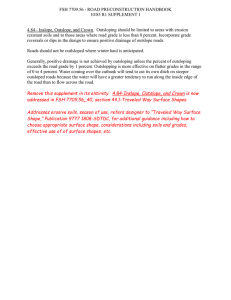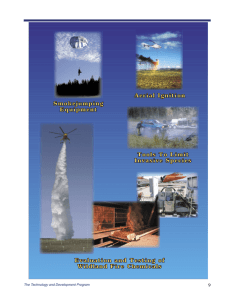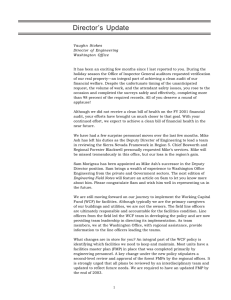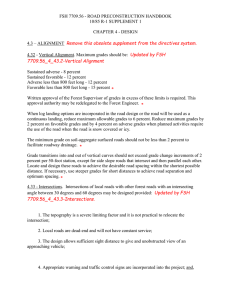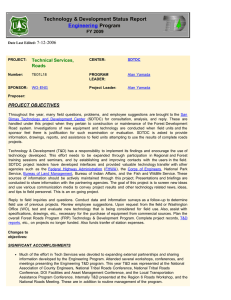Guidelines for Road Maintenance Levels United States
advertisement
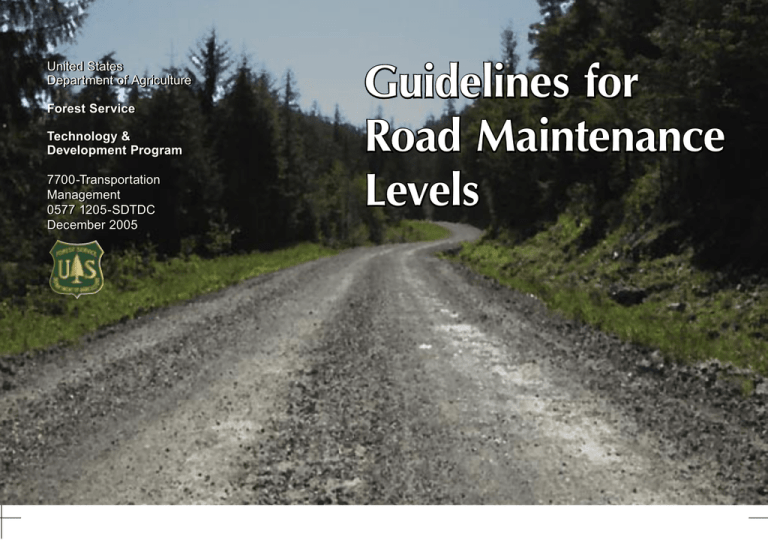
United States Department of Agriculture Forest Service Technology & Development Program 7700-Transportation Management 0577 1205-SDTDC December 2005 Guidelines for Road Maintenance Levels Guidelines for Road Maintenance Levels by Committee for Guidelines for Road Maintenance Levels Leo Ruiz, Civil Engineer, Project Leader Information contained in this document has been developed for the guidance of employees of the U.S. Department of Agriculture (USDA) Forest Service, its contractors, and cooperating Federal and State agencies. The USDA Forest Service assumes no responsibility for the interpretation or use of this information by other than its own employees. The use of trade, firm, or corporation names is for the information and convenience of the reader. Such use does not constitute an official evaluation, conclusion, recommendation, endorsement, or approval of any product or service to the exclusion of others that may be suitable. The U.S. Department of Agriculture (USDA) prohibits discrimination in all its programs and activities on the basis of race, color, national origin, age, disability, and where applicable, sex, marital status, familial status, parental status, religion, sexual orientation, genetic information, political beliefs, reprisal, or because all or part of an individual’s income is derived from any public assistance program. (Not all prohibited bases apply to all programs.) Persons with disabilities who require alternative means for communication of program information (Braille, large print, audiotape, etc.) should contact USDA’s TARGET Center at (202) 720-2600 (voice and TDD). To file a complaint of discrimination, write to USDA, Director, Office of Civil Rights, Room 326-W, Whitten Building, 1400 Independence Avenue, S.W., Washington, D.C. 20250-9410, or call (800) 795-3272 (voice) or (202) 720-6382 (TDD). USDA is an equal opportunity provider and employer. INTRODUCTION This concise guide defines and summarizes road maintenance levels and entrance management strategies, according to U.S. Department of Agriculture (USDA), Forest Service regulations. The explanations and photos can help agency road managers, transportation engineers, and particularly equipment operators and field personnel achieve consistent application of road management and maintenance standards. The USDA Forest Service guidance provided serves as a primer for educating the public and other resource personnel within the USDA Forest Service about how the agency’s transportation system is managed and maintained. 1 Maintenance Levels (FSH 7709.58,10,12.3) Maintenance levels are defined by the USDA Forest Service Handbook (FSH) as the level of service provided by, and maintenance required for, a specific road. Maintenance levels must be consistent with road management objectives, and maintenance criteria. Factors. Consider the following factors when selecting maintenance levels: a. Resource program needs, environmental and resource protection requirements, visual quality objectives, and recreation opportunity spectrum classes. b. Road investment protection requirements. c. Service life and current operational status. d. User safety. e. Volume, type, class, and composition of traffic. f. Surface type. g. Travel speed. h. User comfort and convenience. i. Functional classification. j. Traffic service level. Roads may be currently maintained at one level and planned to be maintained at a different level at some future date. The operational maintenance level is the maintenance level currently assigned to a road considering today’s needs, road condition, budget constraints, and environmental concerns; in other words, it defines the level to which the road is currently being maintained. The objective maintenance level is the maintenance level to be assigned at a future date considering future road management objectives, traffic needs, budget constraints, and environmental concerns. The objective maintenance level may be the same as, or higher or lower than, the operational maintenance level to objective maintenance level may depend on reconstruction or disinvestment. 2 USDA FOREST SERVICE ROAD MAINTENANCE LEVELS (5 through 1) Road Maintenance Level 5 Road maintenance level 5 is defined in the FSH 7709.58,10,12.3 as: Assigned to roads that provide a high degree of user comfort and convenience. These roads are normally double-lane, paved facilities. Some may be aggregate surfaced and dust abated. The appropriate traffic management strategy is “encourage.” These roads have the following attributes: • Subject to the requirements of Highway Safety Act and Manual of Uniform Traffic Control Devices (MUTCD). • Highest traffic volume and speeds. • Typically connect to State and county roads. • Culverts provide drainage. • Usually arterial and collector. • May include some developed recreation roads. • Usually paved or chip-sealed. 3 Level 5 Maintenance prescription guidelines from the FSH 7709.58,10,12.6, exhibit 01 include: • General. As needed. • Traveled way. Maintain surface to provide for the protection of investment and resource values, and for a high degree of user comfort and convenience. • Shoulder. Maintain to the same standard as the traveled way. • Drainage. As necessary to keep drainage facilities functional and prevent unacceptable environmental damage. • Roadway. Maintain existing vegetative cover. Control vegetation to provide sight distance. Repair and/or remove slides and slumps to provide passage by prudent drivers in standard passenger cars. • Roadside. Clean up litter in accordance with road management objectives. Remove hazard trees and perform landscape treatments as required. • Structures. Maintain all structures to provide for passage of planned traffic and to preserve structures for future use. Defer noncritical items and combine to provide for a more economical project. For example, defective bridge rails, running planks, and bridge guideposts on a current basis. Defer painting of bridge rails to a logical project cycle. • Traffic service. Install and maintain route markers; warning, regulatory, and guide signs; and other traffic devices to provide for planned traffic. Renew centerlines, edge stripes, and other pavement and curb markings as needed to provide for planned traffic. 4 Figure 1—Maintenance level 5 road with double lanes, hot-mix asphalt surface, and asphalt- and rock-stabilized shoulders. 5 Figure 2—Maintenance level 5 road with double lanes, asphalt surface, and unpaved shoulders. 6 Figure 3—Maintenance level 5 road with double lanes, chip-seal surface, and unpaved shoulders. 7 Figure 4—Maintenance level 5 road with double lanes, asphalt surface, and grass on asphalt shoulder. 8 Figure 5—Maintenance level 5 road with double lanes, asphalt surface, and asphalt shoulders. 9 Road Maintenance Level 4 Road maintenance level 4 is defined in the FSH 7709.58,10,12.3 as: Assigned to roads that provide a moderate degree of user comfort and convenience at moderate travel speeds. Most roads are double lane and aggregate surfaced. However, some roads may be single lane. Some roads may be paved and/or dust abated. The most appropriate traffic management strategy is “encourage.” However, the “prohibit” strategy may apply to specific classes of vehicles or users at certain times. These roads have the following attributes: • Subject to the requirements of the Highway Safety Act and MUTCD. • Roads have moderate traffic volume and speeds. • May connect to county roads. • Culverts provide drainage. • Usually a collector. • May include some developed recreation roads. 11 Level 4 Maintenance prescription guidelines from the FSH 7709.58,10,12.6, exhibit 01 include: General. As needed. Traveled way. Maintain traveled way to provide for moderate degree of user comfort and convenience and for protection of investment and resource values. Replace surfacing to the depth required for blade maintenance and to prevent wear of the base course. Abate dust when needed. Shoulder. Maintain existing shoulders commensurate with the traveled way. Drainage. As necessary to keep drainage facilities functional and prevent unacceptable environmental damage. Roadway. Maintain existing vegetative cover. Control vegetation to provide sight distance. Repair and/or remove slides and slumps to provide passage by prudent drivers in standard passenger cars. Roadside. Clean up litter in accordance with road management objectives. Remove hazard trees and perform landscape treatments as required. Structure. Maintain all structure to provide for passage of planned traffic and to preserve structures for future use. Defer noncritical items and combine to provide for a more economical project. For example, defective bridge rails, running planks, and bridge guideposts on a current basis. Defer the painting of bridge rails to a logical project cycle. Traffic service. Install and maintain route markers; warning, regulatory, and guide signs; and other traffic devices to provide for planned traffic. 12 Figure 6—Maintenance level 4 road with double lanes, gravel surface, and gravel shoulders. 13 Figure 7—Maintenance level 4 road with double lanes, asphalt surface, and no shoulders. 14 Figure 8—Maintenance level 4 road with a single lane, asphalt surface, no shoulders, and paved turnouts. 15 Figure 9—Maintenance level 4 road with single lane, gravel surface, and gravel shoulders. 16 Figure 10—Maintenance level 4 road with single lane, chip-seal surface, and chip-seal shoulders. 17 Figure 11—Maintenance level 4 road with single lane, gravel surface, and gravel shoulders. 18 Road Maintenance Level 3 Road maintenance level 3 is defined in the FSH 7709.58,10,12.3 as: Assigned to roads open and maintained for travel by prudent drivers in a standard passenger cars. User comfort and convenience are low priorities. Roads in this maintenance level are typically low speed, single lane with turnouts, and spot surfacing. Some roads may be fully surfaced with either native or processed material. Appropriate traffic management strategies are either “encourage” or “accept.” “Discourage” or “prohibit” strategies may be employed for certain classes of vehicles or users. These roads have the following attributes: • Subject to the requirements of Highway Safety Act and MUTCD. • Roads have low- to moderate-traffic volume. • Typically connect to arterial and collectors roads. • A combination of dips and culverts provide drainage. • May include some dispersed recreation roads. • Potholing or washboarding may occur. 19 Level 3 Maintenance prescription guidelines from the FSH 7709.58,10,12.6, exhibit 01 include: General. As needed. Traveled way. Maintain surface to provide travel by prudent drivers in standard passenger cars. Some surface roughness is tolerated. User comfort and convenience is a low priority. Maintain a traveled way crown or cross slope to provide adequate drainage. Replace the base course and surfacing as needed. Shoulder. Maintain existing shoulders commensurate with the traveled way. Drainage. As necessary to keep drainage facilities functional and prevent unacceptable environmental damage. Roadway. Maintain existing vegetative cover. Control the vegetation to provide sight distance. Repair and/or remove slides and slumps to provide passage by prudent drivers in standard passenger cars. Roadside. Remove hazard trees and clean up litter. Structure. Maintain all structures to provide for passage of planned traffic and to preserve structures for future use. Defer noncritical items and combine to provide for more economical project. For example, defective bridge rails, running planks, and bridge guideposts on a current basis. Defer the painting of bridge rails to a logical project cycle. Traffic service. Install and maintain route markers; warning, regulatory, and guide signs; and other traffic devices to provide for planned traffic. 20 Figure 12—Maintenance level 3 road with single lane, gravel surface, and gravel shoulders. 21 Figure 13—Maintenance level 3 road with single lane, gravel surface, and gravel shoulders. 22 Figure 14—Maintenance level 3 road with single lane, gravel surface, and gravel shoulders. 23 . Figure 15—Maintenance level 3 road with single lane, gravel surface, and gravel shoulders. 24 Figure 16—Maintenance level 3 road with single lane, gravel surface, no shoulders, and a cross drain dip. 25 Figure 17—Maintenance level 3 road with single lane, gravel surface, and no shoulders. 26 Figure 18—Maintenance level 3 road with double lanes and native road surface with shoulders. 27 Figure 19—Maintenance level 3 road with single lane, gravel surface, and no shoulders. 28 Figure 20—Maintenance level 3 road with single lane, gravel surface, and no shoulders. 29 Road Maintenance Level 2 Road maintenance level 2 is defined in the FSH 7709.58,10,12.3 as: Assigned to roads open for use by high-clearance vehicles . Passenger car traffic is not a consideration. Traffic is normally minor, usually consisting of one or a combination of administrative, permitted, dispersed recreation, or other specialized uses. Log haul may occur at this level. Appropriate traffic management strategies are either to (1) discourage or prohibit passenger cars or (2) accept or discourage high-clearance vehicles. These roads have the following attributes: • Roads have low traffic volume and low speed. • Typically local roads. • Typically connect collectors or other local roads. • Dips are the preferred drainage treatment. • Not subject to the requirements of the Highway Safety Act. • Surface smoothness is not a consideration. • Not suitable for passnger cars. 31 Level 2 Maintenance prescription guidelines are from the FSH 7709.58,10,12.6, exhibit 01 and include: General. As needed. Traveled way. Log out and brush as necessary to provide passage for planned traffic. Maintain road prism to provide for passage of high-clearance vehicles. Shoulder. Maintain only as necessary for planned traffic. Drainage. As necessary to keep drainage facilities functional and prevent unacceptable environmental damage. Roadway. Manage vegetative cover as needed for planned traffic. Remove and/or repair slides and/or slumps as needed for access with high clearance vehicles to control resource damage. Roadside. Generally no work is required. Structure. Maintain all structures to provide for the passage of planned traffic. Traffic service. Install and maintain route markers; warning, regulatory, and guide signs; and other traffic control devices to provide for planned traffic and an appropriate traffic management strategy. 32 Figure 22—Maintenance level 2 road with single lane, pit-run surface, no shoulders. 33 Figure 23—Maintenance level 2 road with single lane and native surface. 34 Figure 24—Maintenance level 2 road with single lane, pit-run surface, no shoulders, and suitable for high-clearance vehicles, but with very limited sight distance due to extreme vegetative encroachment. 35 Figure 25—Maintenance level 2 road with single lane, native surface, no shoulders, and suitable for high-clearance vehicles only. 36 Figure 26—Maintenance level 2 road with single lane, native surface, no shoulders, and suitable for high-clearance vehicles only. 37 Figure 27—Maintenance level 2 road that has been “temporarily” closed. 38 Road Management Level 1 Road management level 1 is defined in the FSH 7709.58,10,12.3 as: Assigned to intermittent service roads during the time they are closed to vehicular traffic. The closure period must exceed 1 year. Basic custodial maintenance is performed to keep damage to adjacent resources to an acceptable level and to perpetuate the road to facilitate future management activities. Emphasis is normally given to maintaining drainage facilities and runoff patterns. Planned road deterioration may occur at this level. Appropriate traffic management strategies are “prohibit” and “eliminate.” Roads receiving level 1 maintenance may be of any type, class or construction standard, and may be managed at any other maintenance level during the time they are open for traffic. However, while being maintained at level 1, they are closed to vehicular traffic, but may be open and suitable for nonmotorized uses. These roads have the following attributes: • Vehicular traffic is eliminated, including administrative traffic. • Physically blocked or entrance is disguised. • Not subject to the requirements of the Highway Safety Act. • Maintenance is done only to minimize resource impacts. • No maintenance other than a condition survey may be required so long as no potential exists for resource damage. 39 Level 1 Maintenance prescription guidelines are from the FSH 7709.58,10,12.6, exhibit 01 and include: General. As needed. Traveled way. Generally no work is required. Shoulder. Generally no work is required. Drainage. As necessary to keep drainage facilities functional and prevent unacceptable environmental damage. Roadway. Perform only that work needed to facilitate restoration of the roadway for future use and to alleviate erosion or sedimentation on or from the roadway or roadsides. Normally, defer the removal of brush and trees from the roadway. Vehicle traffic is not a consideration. Roadside. Generally no work is required. Structure. Inspect and repair only those items that cannot be deferred, and that are necessary to protect investment, and preserve structural integrity. Traffic service. Ensure that physical closure devices and/or appropriate signing are in place and functional at the road entrance. Defer the maintenance of signs within the closure until the road is opened. Correct deferred items prior to opening the road to traffic. 40 Figure 28—Maintenance level 1 road that has been blocked to highway vehicle traffic by an earth mound. 41 Figure 29—Maintenance level 1 road that has been blocked to highway vehicle traffic by an earth mound. 42 Figure 30—Maintenance level 1 road that has been blocked to highway vehicle traffic by boulders. 43 Figure 31—Maintenance level 1 road that has been blocked to highway vehicle traffic by posts. Also includes a sign prohibiting motorized vehicles. 44 Figure 32—Maintenance level 1 road that has been blocked to highway vehicle traffic by natural vegetative overgrowth. 45 Figure 33—Maintenance level 1 road with the highway vehicle traffic eliminated by a vegetated earth mound, which both disguises and physically blocks the road. 46 Figure 34—Maintenance level 1 road with highway vehicle traffic eliminated by a barricade and posts. 47 ROAD MANAGEMENT STRATEGIES This section describes the road management objectives and provides examples of the five basic strategies for managing traffic on roads excluded from the Highway Safety Act (Maintenance Levels 2 and 1). Descriptions and locations of route markers, entrance signs, and other traffic control devices are included. Traffic Control Devices and Roads Excluded From the Highway Safety Act General Information These roads are not intended to be passable or used by the public in a standard four-wheeled passenger car. Information at road entrances should inform the user that the road is not intended for use in a standard passenger car. Even though the Highway Safety Act does not apply to these roads, road user safety is still a concern. While MUTCD standards apply to all signs and traffic control devices installed, the size, message, and material may vary as long as they meet these standards. See EM-7100-15, Sign and Poster Guidelines for the Forest Service, for further information on signs and traffic control devices. Recreation symbols also should conform with EM-7100-15 guidance. Devices other than signs, such as barriers, cross ditches, and so forth, will often be used on these roads. The design of these devices must consider the safety of any summer motorized trail users or winter snowmobile users. Signs may be required for information purposes at the road entrance and for trail and snowmobile users at any road traffic control devices that present a hazard to trail or snowmobile traffic. Where roads excluded from the Highway Safety Act intersect roads that are included under the act, inform the road user about road condition and the road’s intended purpose. Information may also be needed at other intersections as the road management strategy changes. Policy on safety and road operations is found in FSH 7709.59, Road System Operations Handbook. 48 Five Basic Strategies The USDA Forest Service has five basic strategies for managing traffic on roads excluded from the Highway Safety Act: encourage, accept, discourage, eliminate, and prohibit. Combinations of these strategies may be applied to different user groups on the same road or trail. These five strategies are discussed below. ENCOURAGE The objective is to encourage use by high-clearance vehicles (pickups, trucks, 4 by 4s, and so forth) and discourage passenger cars. This is accomplished by using information techniques such as maps and guide signing. The road is operated at the standard appropriate to the intended use and requires maintenance level 2. These roads are shown on the motor vehicle use map. Route marker. Use standard vertical administrative markers. Entrance signs. Directional signs or recreation symbols should depict the specific use being encouraged. Other entrance devices. Normally, the entrance devices have one or two cross ditches or a sign discouraging passenger cars that should be clearly visible at the road entrance. Other traffic control devices. Use warning signs or object markers only to mark hazardous conditions. Continue to use route markers at other intersections, where needed. ACCEPT The objective is to accept high-clearance vehicles and discourage passenger cars. The road is passable and adequate for administrative use and requires maintenance level 2. Some public use may occur until passage becomes unsafe or resource damage becomes unacceptable. At that point, the management strategy should be changed to eliminate or prohibit use. Roads with an “accept” strategy are shown on the motor vehicle use map. 49 Strategies Route marker. Use standard vertical administrative markers. Entrance signs. No directional sign should be used. Other entrance devices. Normally, one to two cross ditches, or a sign discouraging passenger cars should be visible at the road entrance. Other traffic control devices. A warning sign may be needed at the last safe turnaround. DISCOURAGE The objective is to discourage all public use during certain periods. At the road entrance passage appears feasible, but entrance information is designed to discourage the general public with advisory signs, warnings, and/or barriers. The maintenance level may vary according to contact or permit requirements. These roads are shown on the motor vehicle use map. Route markers. Place route markers in accordance with road management strategy during noncommercial-use period. Use standard vertical administrative markers. Entrance signs. No signing should be used at road entrances. Other traffic control devices. Usually none are needed, unless to satisfy regulations of the Occupational Safety and Health Administration, USDA Forest Service Manual 6709.11, Health and Safety Code Handbook, and similar authorities. ELIMINATE Under this strategy, all use is eliminated. The road is physically blocked rather than relying on regulations. Barriers include guardrails, logs or boulders, earthen mounds, or trees and brush used to camouflage the road entrance. The strategy does not include gates. Maintenance level 1 is required. These roads are not shown on the motor vehicle use 50 map. While that automatically prohibits use of the road under 36 CFR 261.13, USDA Forest Service law enforcement resources are very limited and are better used elsewhere when traffic can be stopped with an eliminate strategy. Route markers. Place route markers on a vertical post near the road entrance for administrative purposes. Entrance signs. Normally, entrance signs will not be used. Occasionally, a temporary sign may be needed. Other entrance devices. The roadway should be blocked physically with a barrier other than a gate. Other traffic control devices. Use the route number on a vertical post at other intersections. The “Commercial Use Only” sign should be used when commercial use is authorized by contract or permit. PROHIBIT Under this strategy, certain or all users are not allowed to use the road. This is signed and actively enforced under a regulatory order. This strategy allows the use of gates. Maintenance level may vary in accordance with contract or permit requirements. When public motor vehicle use is prohibited year round, roads are not shown on the motor vehicle use map and use is prohibited by 36 CFR 261.13. When seasonal public use is allowed, roads are shown on the motor vehicle use map, restrictions are shown on the motor vehicle use map, and an order under 36 CFR 261.54 must be in place to prohibit seasonal use. Route markers. Place route markers in accordance with the road management strategy during the noncommercial-use period. Use standard vertical administrative markers. Entrance signs. Use a regulatory sign to prohibit public use when a seasonal closure under 36 CFR 261.54 is in effect. Signing is unnecessary for year-round closures implemented by not showing roads on the motor vehicle use map. The “Commercial Use Only” sign should be used when commercial use is authorized by contract or permit. 51 Right-of-Way Roadside Clearing Width Roadway Ground Line Road bed Shapes and dimensions will vary to fit local conditions. See drawings for typical sections. X and Y denote clearing outside of roadway. 52 Berm Surface Course Base Course Subgrade Fill Slope Clearing Limit Back slope Traveled Way CL Shoulder Ground Line Drainage Ditch Note: Y Right-of-Way Line X Shoulder Right-of-Way Line Clearing Limit Roadside Committee for Guidelines for Road Maintenance Levels: Marjorie Apodaca, transportation systems management group leader, USDA Forest Service, Southwest Region Mike Noland, civil engineer, road operation and maintenance, USDA Forest Service, Southwest Region Jeff Derrick, public roads engineer, USDA Forest Service, Southern Region Jim Kozik, operations/maintenance engineer, USDA Forest Service, Southern Region Lawrence (Jim) Abernathy, traffic control engineer, USDA Forest Service, Pacific Northwest Region Leo Ruiz, civil engineer, project leader, USDA Forest Service, San Dimas Technology and Development Center, San Dimas, CA The SDTDC staff wishes to thank the following individuals for their review of this publication: Marcia Hughey, transportation development/dams/geotech/material, USDA Forest Service, Northern Region Jeff Moll, transportation operations and maintenance engineer, USDA Forest Service, Rocky Mountain Region Richard Kennedy, transportation planning and development, USDA Forest Service, Intermountain Region Kristine (Kris) A. Smith, transportation program leader, USDA Forest Service, Eastern Region John Bell, civil engineer, transportation systems operations and maintenance, USDA Forest Service, Washington, DC Bill Fodge, road operation and maintenance engineer, USDA Forest Service, Pacific Southwest Region 53 Mary Miller, regional transportation engineer, USDA Forest Service, Alaska Region Peter Fama, civil engineer, USDA Forest Service, Alaska Region Useful References Forest Service Handbook, Web site: http://fsweb.wo.fs.fed.us/directives/html/fsh7000.shtml Forest Service Manual, Web site: http://fsweb.wo.fs.fed.us/directives/html/fsm7000.shtml Manual on Uniform Traffic Control Devices, Web site: http://mutcd.fhwa.dot.gov/ Sign and Poster Guidelines for the Forest Service 2005 edition, Web site: http://fsweb.wo.fs.fed.us/eng/roads_trails/signs_05/ Highway Safety Act, Title 23 CFR Web site: http://www.nhtsa.dot.gov/nhtsa/whatsup/tea21/GrantMan/HTML/07_Sect402Leg23USC_Chap4.html Additional Information For additional infromation on USDA Forest Service Road maintenance levels, contact Leo Ruiz at SDTDC by phone: 909-599-1267, ext. 258, or e-mail: lruiz@fs.fed.us SDTDC's national publications are available on the Internet at: http://www.fs.fed.us/eng/pubs/ Forest Service and U.S. Department of the Interior Bureau of Land Management employees also can view videos, CD's and SDTDC's individual project pages on their internal computer network at: http://fsweb.sdtdc.wo.fs.fed.us/

